

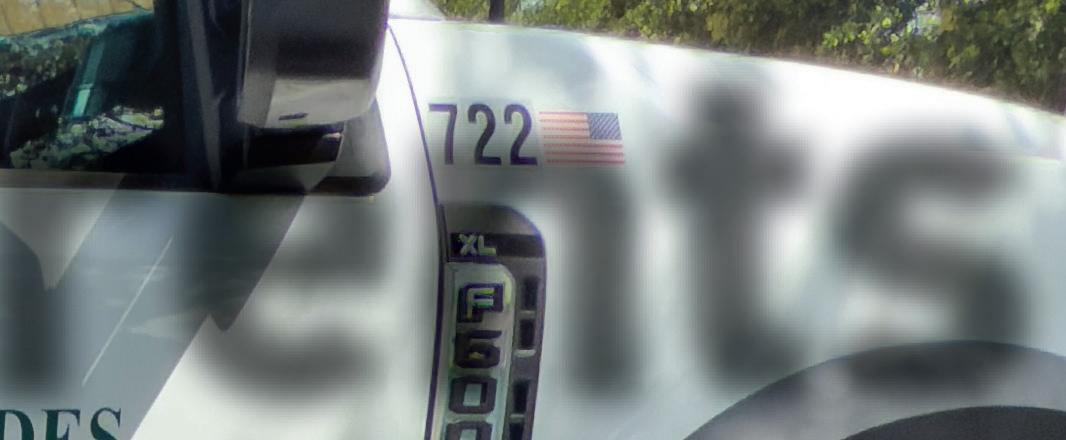







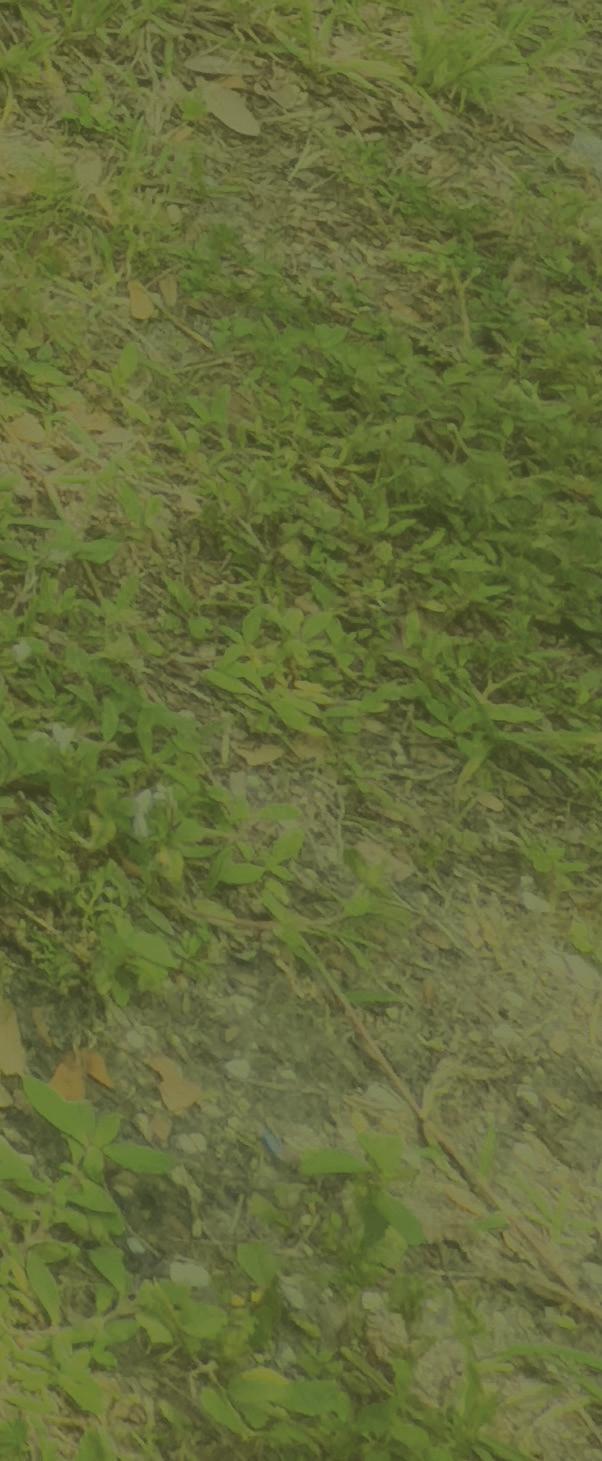

“

August 2025 • Volume 14, No. 10
CEO Michael Shepard
VICE PRESIDENT OF CONTENT Leon Espinoza
EDITORIAL DIRECTOR Chasity Anderson, CCC
DEPUTY EDITORIAL DIRECTOR
Noble Sprayberry
SENIOR EDITOR Jennifer Paton, CCC
FLORIDA CURRENTS EDITORS
Valeri Saldanha Rosa; Sable Riley, CCC
ASSISTANT EDITORS Victoria Hampton, CCC; David Herder, CCC
ASSOCIATE EDITOR
Nina Todea
PUBLICATIONS PRODUCTION
SENIOR MANAGER
Elizabeth Beatty
SENIOR PUBLICATIONS COORDINATOR
Alyssa McDougle
Members acknowledge that $4.49 a year, plus postage, is the cost to publish 12 issues a year of FLORIDA CURRENTS ISSN 23276304 (USPS 8300). Published by Pioneer Utility Resources Inc., 5625 NE Elam Young Pkwy. Ste. 100, Hillsboro, OR 97124—a not-for-profit Oregon cooperative corporation—the magazine serves the communication needs of consumerowned electric utilities in Florida. Preferred Periodicals postage paid at Hillsboro, OR 97123 and at additional mailing offices.
Postmaster: Send address changes to 5625 NE Elam Young Pkwy., Ste. 100, Hillsboro, OR 97124-6422.
HOW TO CONTACT FLORIDA CURRENTS
Subscription services:
Nonmember subscriptions $15 U.S. a year; $25 foreign a year. Prepayment required. Allow 4-8 weeks for first issue. Identify local edition desired. Have a problem receiving your magazine? Utility members should contact their utility office. Nonmembers call 503-357-2105 or email mailingdept@pioneer.coop.
Back issues:
Back issues and extra copies are $3 each, prepayment required. Supply is limited. Identify edition, month and year. Call first to check availability. Contact Pioneer Utility Resources: P.O. Box 1306, North Plains, OR 97133-1306; 503-357-2105; email: mailingdept@pioneer.coop.
DISPLAY ADVERTISING INQUIRIES
American MainStreet Publications 611 S. Congress Ave. Ste. 504 Austin, TX 78704-1714; 800-626-1181 or 512-441-5200; amp.coop. © 2025 Pioneer Utility Resources. All rights reserved. Reproduction in whole or in part without written permission is prohibited. Direct reprint requests to editor@floridacurrents.com or for more information, visit www.pioneer.coop.





For additional content, search @FloridaCurrents on your favorite social media sites and floridacurrents.com.



When hurricane season approaches, Glades County works together to prepare. That community spirit was evident June 10 at the Hurricane Preparedness Fair at Riverside Park in Moore Haven. Glades Electric Cooperative joined local organizations in educating students and residents about storm safety and what they can do be ready for a major storm.
The cooperative’s lineworkers and safety personnel brought their energized Safety City display to demonstrate the dangers of downed power lines and electrical hazards. Students gathered around the display and were especially interested to see how various objects and animals can contact a line and cause an outage.
Students received educational booklets, ensuring electrical and hurricane safety knowledge would make its way into their homes.
The event brought together multiple county agencies, each contributing their expertise to community preparedness. The county’s Emergency Operations Center brought an ambulance and shared
information about prestorm preparations and poststorm recovery. The health department addressed hygiene and water safety concerns during extended outages, and school food services highlighted its capability to provide emergency meals to students and community members during recovery periods.
Glades County Schools and Highland Electric Fleet showcased electric school buses as mobile charging stations and cooling centers. The buses powered a snow cone machine, demonstrating the potential to power community resources during extended outages.
“My biggest hope is that the young people of Glades County left the event with a stronger sense of awareness and readiness for potential extended power outages from storms,” says Dan Thomas, event organizer and Glades County School District director of administrative services. “I want them to clearly see the resources and support available to them.”
The fair represented more education beyond preparedness, also

showcasing the interconnected network of support that makes Glades County resilient. From Glades Electric’s crew members who risk their lives restoring power in dangerous conditions to the schools that serve as community shelters to the health department ensuring public safety, every organization plays a vital role.
“While we never wish for storms or long-term power outages, it’s reassuring to know that we’ve empowered the residents of Glades County with knowledge,” Dan says. “My hope is that next year’s event will continue to grow, further strengthening our community’s resilience, and ensuring even more of our youth and adults are equipped to face future challenges.”
For Glades Electric Cooperative, participating in the Hurricane Preparedness Fair represents a cooperative principle in action: Concern for Community.
When the next storm threatens, Glades County will be powered by knowledge, preparation and the collaboration of local organizations. n
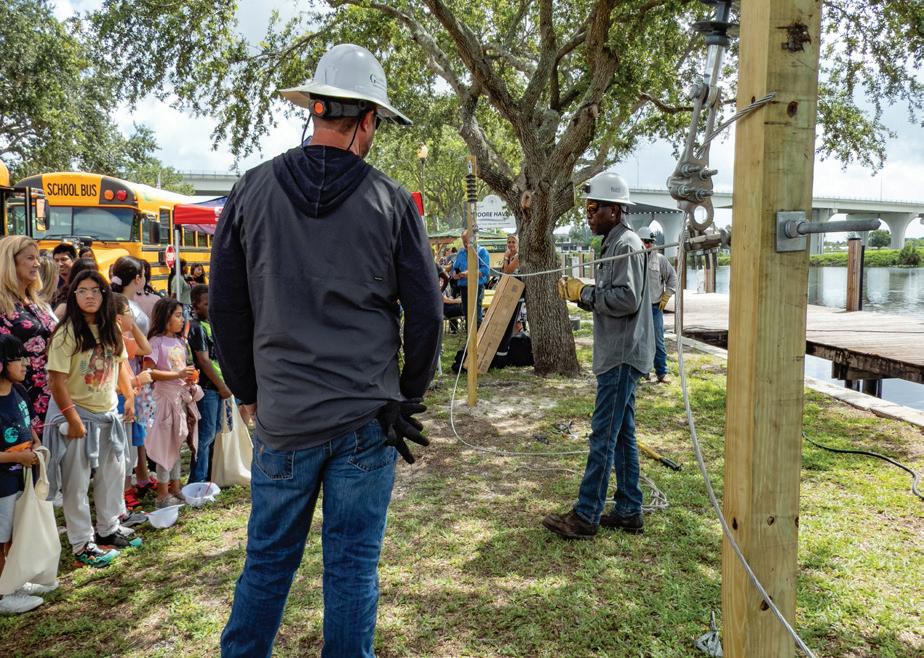
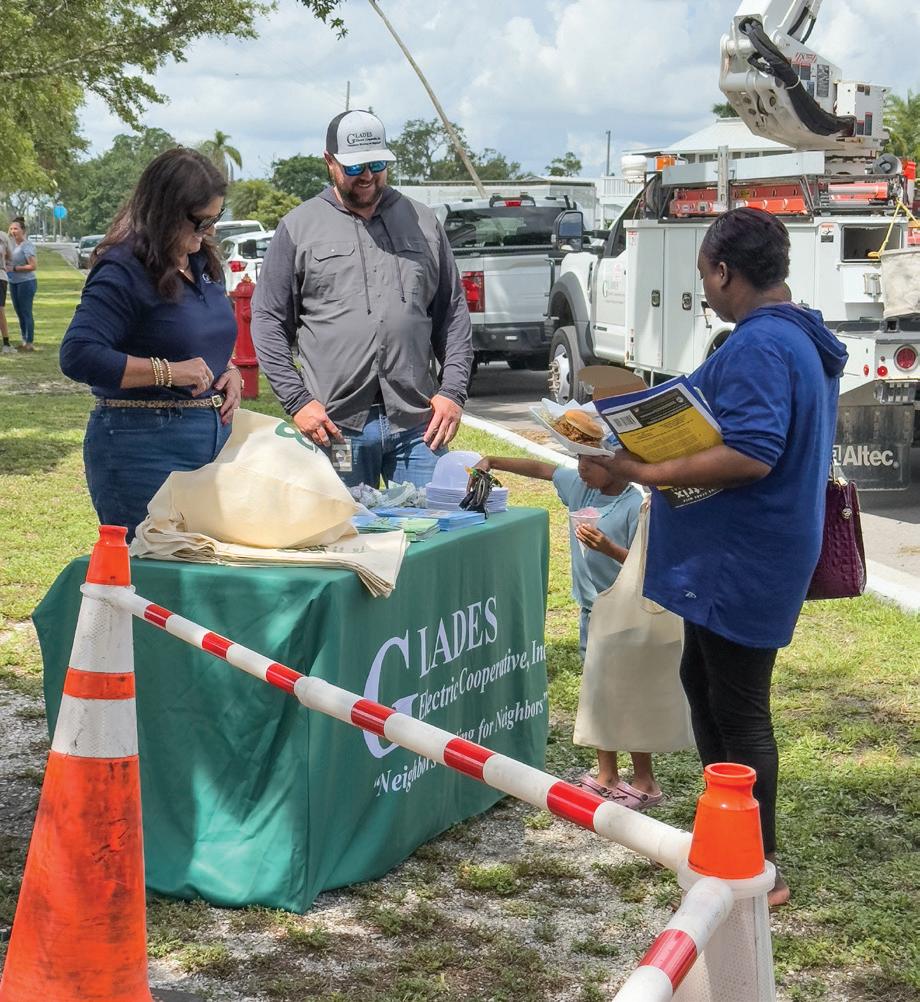







Students of all ages who are powered by Glades Electric Cooperative are eligible to apply for a $2,000 scholarship to iTECH Glades. For details and a scholarship application, visit www. gladeselectric.com/community/ student-programs-information. Reach out to scholarships@ gladeselectric.com if you have questions.




Glades Electric uses advanced metering infrastructure to enhance service to members. Meters can be reconnected or disconnected remotely. Be sure to leave all unattended appliances off. In the event your service is unexpectedly connected or reenergized, unattended appliances left on could cause a fire or safety hazard.









Update your contact information. Ensure we have your current phone number and email for quick outage reporting and important updates. Update this information via SmartHub, by emailing memberservices@gladeselectric.com, through our web contact form or by calling the co-op from 7 a.m. to 6 p.m. Mondays through Thursdays. Stay informed. Restoration updates will be on our Facebook page (facebook.com/ GladesElectricCooperative) at 9:30 a.m. and 7:30 p.m. daily. No Facebook account is needed to view the page. Help restore outages quickly and maintain equipment. If you have a gate, contact the co-op to provide your gate code or get a Glades Electric lock. Call 855-940-3810, use SmartHub to request a lock or share your gate code, or use the Contact Us QR code on the right to use our web contact form.





Summer campers at Archbold Biological Station had the opportunity to visit Buck Island Ranch, thanks to Glades Electric Cooperative members’ Operation Round Up donations.
Buck Island Ranch is a 10,500acre working cattle ranch with nearly 3,000 head of cattle and home to Archbold’s Agroecology Program.
Without funding for transportation, this unique, hands-on learning experience wouldn’t be possible. Your small change makes a big difference— supporting education and crisis funding in the community.
Archbold has hosted weeklong summer day camps for more than 30 years. Over the course of four
one-week summer sessions each year, 65-100 local students ages 7 to 12 are introduced to the ecology, natural landscapes and agriculture of the Florida Heartland.
The camps utilize Archbold’s 20,000 acres of outdoor classrooms. Students meet scientists, visit a scrub preserve, tour Buck Island Ranch, explore a seasonal pond and swim in an ancient sinkhole lake.
Join Operation Round Up and have your bill rounded up to the next dollar to support local youth programs, community nonprofits and members in financial crisis situations.
It’s easy in the SmartHub app or scan the QR code to sign up through our website’s Contact Us form.





What is it?
Operation Round Up is a program that allows members to round up their monthly bills to fund projects benefiting community members in need.
Nine members serve on the board of directors for Glades Electric Charitable Trust, a 501(c)(3) nonprofit organization. Directors review applications and approve grants.










How does it work?
$153 55 cents to your neighbor in need. The average yearly contribution is $6 per member.


Funds from Operation Round Up go right back into the communities we serve.
$5,750.00 in Operation Round Up funds awarded in June 2025 for youth and educational services.
8,224 accounts participate in Operation Round Up or Operation Round Up Plus. Round Up Plus allows members to add any set amount, $1 or more, to their bills each month.
44%


How can I help?
Sign up for Operation Round Up in the SmartHub app or on your payment stub, stop by the office or call 855-940-3810.
$4,350.77
raised by Operation Round Up and Round Up Plus in May 2025.


























How can I get help?
If you or a member you know needs financial assistance, please complete an application at: www.gladeselectric.com/community/operation-round-up. $152.45 Amount due: Power Bill UP ROUND


The participation rate that would raise more than $70,000 annually to support our communities. 75%





















































































By Melanie Jones
Don’t expect to see a hymnal or hear a longwinded sermon at Cowboy Up Church in Plant City. The only sign you’re in a church is a cross next to the riding pen. And while it may not feel like church, the congregation hears good horse training tips and about 15 minutes of preaching on how training a horse relates to building a relationship with God.
Cowboy churches are for people who normally wouldn’t attend a worship service. Cowboy Up takes it further.
“From the few cowboy churches that I’ve been to or watched on TV or Facebook,

the only thing different is they wear their cowboy hats and boots,” preacher Skipper Calder says. “It’s still church just like it always was—they sing some songs, they do a sermon and they take up an offering.”

Cowboy Up has no singing or offering plates.
“We use a horse,” Skipper says. “We’re trying not to be too churchy. We don’t want it to look like a church because we’re trying to reach people who do not go to church. We call it horse training with a message.”
The services are held in a pole barn at a riding stable. At Cowboy Up, there are not a lot of rules and regulations, Skipper says. It’s a relationship.

“That’s what we teach with the horse,” he says. “The horse-human relationship is the closest relationship there is on Earth to man and God. Man and dog isn’t a good illustration. But a horse, if he doesn’t like you, he won’t be good to you. He won’t be kind. He won’t be obedient. You have to become his leader, where with a dog, they just love you anyhow.”
Before Sunday services at Cowboy Up,



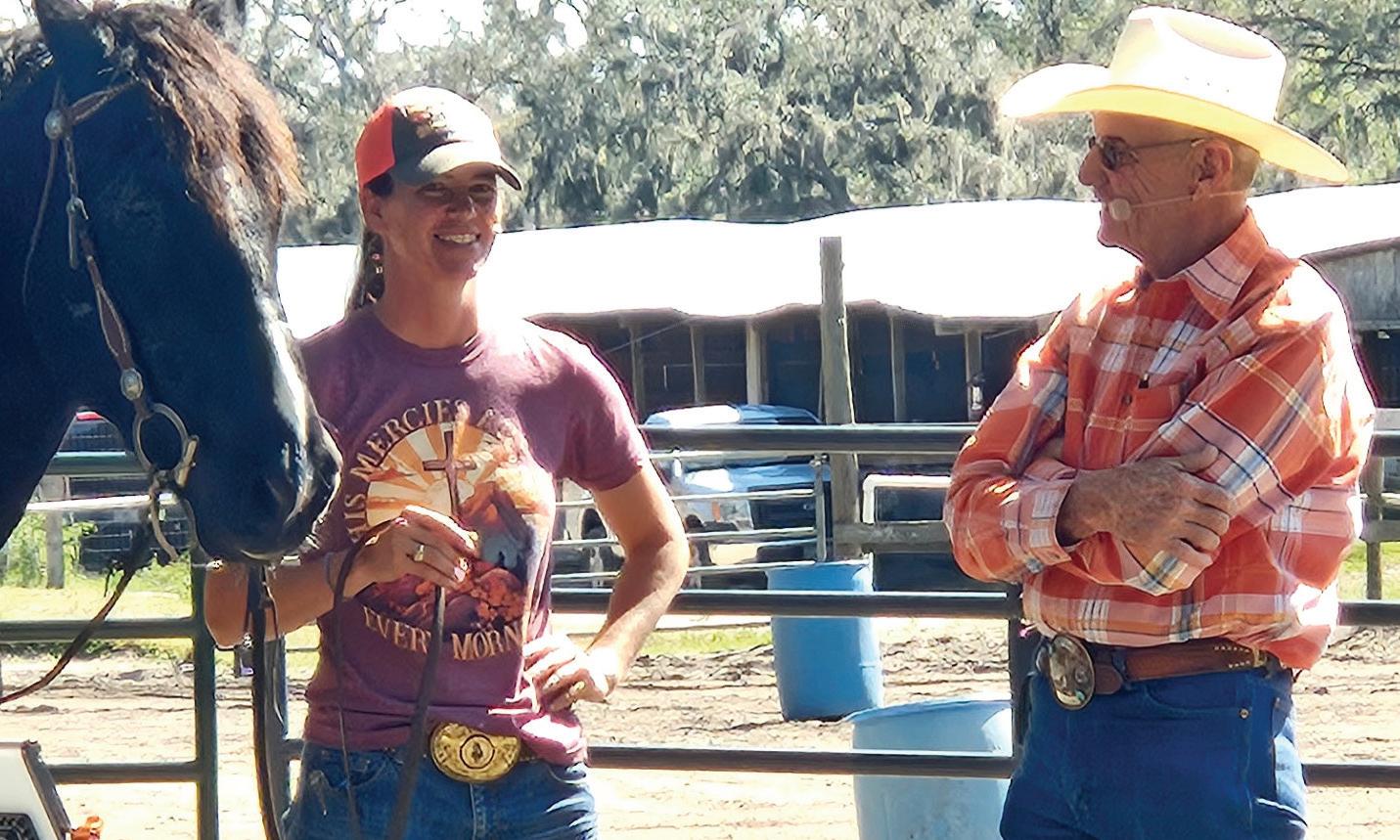








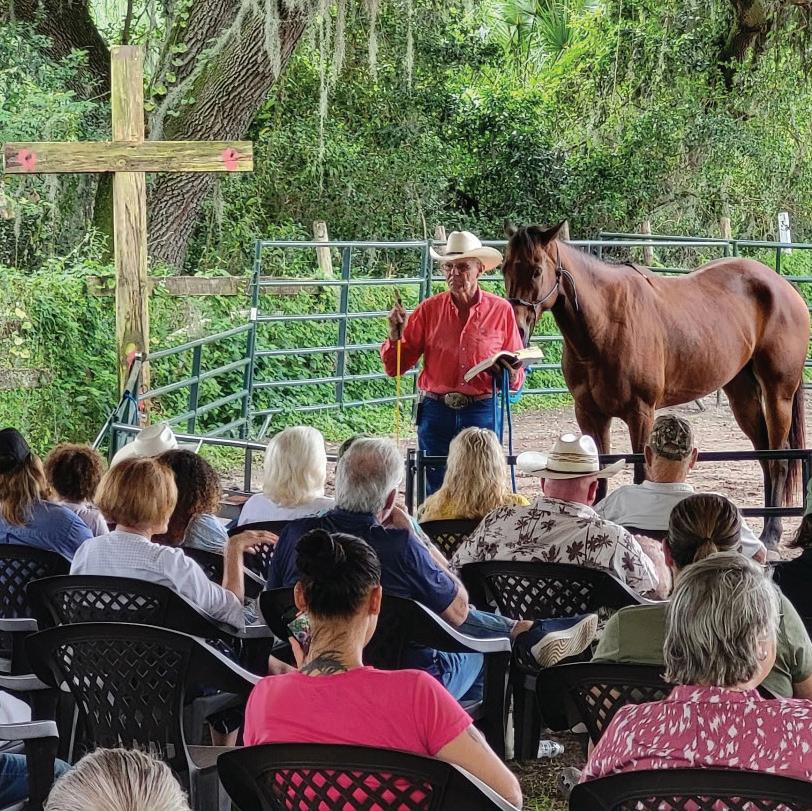


Skipper, his wife, Kathy, and other leaders show up 30 minutes early to pray in the riding pen and the pole barn for the message, the people who will attend and for church services everywhere.
Skipper has no trouble finding horses. People come to him to train their animals. He generally has a few to choose from each Sunday, and he doesn’t use the same horse twice. If a horse owner doesn’t show up with the animal scheduled for that Sunday, he can always find one at the riding stables where church services take place.

“Whatever the horse gives me, I have the gift of relating that to our relationship with God,” he says. “And while I’m working with a horse, I can make statements that will talk about, this looks like us and God sometimes. ‘Avoidance always comes before surrender’ is one of them.
“Focusing on the world instead of the trainer is huge. Many times, I get really
excited, nervous horses, and it’s because, in their mind, they are the leader. Jesus taught us to be a follower. As a trainer, I can get this horse to follow me pretty quick, and then he finds peace.
“That’s the essence of what we want to do is help people find peace through Jesus.”
Skipper did not take the straight road into ministry, but the cowboy part came naturally.
“I grew up the cowboy way,” he says. “I am a cowboy. I love the cowboy way, riding different horses, training horses.”
Before establishing the church, Skipper rode in rodeos for five years. He won seven saddles, some buckles and endured his share of injuries along the way.

“I’ve had 44 broken bones and have three artificial joints,” he says. “It’s a rough life. Part of my broken bones is that every time a horse bucked me off, I broke ribs. A
lot of them were the same ribs. That’s how I accumulated so many.
“I love the life, but it’s a very hard life,” he adds. “I’m sure glad God changed my direction to where I can keep doing what I love—working with horses and talking about God.”
Skipper didn’t understand having a relationship with God, as he puts it, until tragedy struck.
He and his wife were friends with neighbors who were expecting a baby. The wife went into labor early, and the baby and the mother died. All the friends were heartbroken, but the woman’s father came around and spoke with each of them, telling them she was at peace in God’s arms.

“The belief that he had, the strength that he had, I wanted that,” Skipper says. “I wanted that peace.”
Cowboy Up Church meets at 11 a.m. Sundays at 5534 Turkey Creek Road in Plant City.
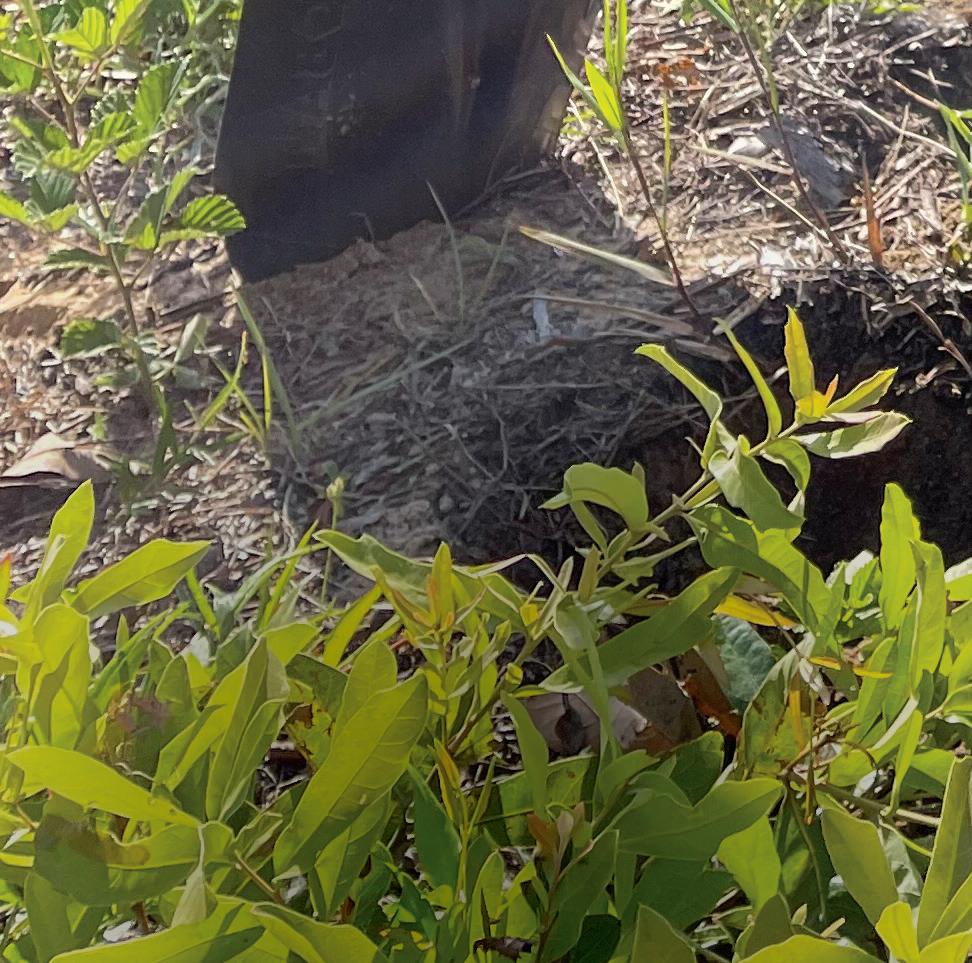

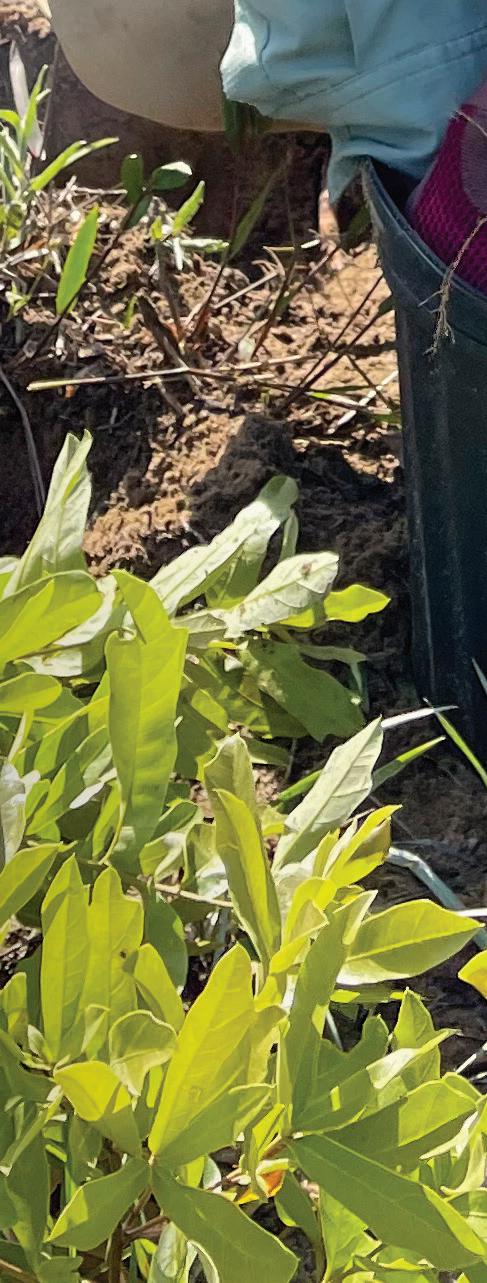





















By Pamela A. Keene
If you have ligustrum, Bradford pear trees, heavenly bamboo or English ivy in your yard, you’re growing a potentially invasive species that can change the balance of nature.





“The definition of an invasive plant is threefold,” says Lilly Anderson-Messec, director of North Florida Programs for the Florida Native Plant Society. “One, it has its origin somewhere else. Two, it spreads rapidly. And three, it has negative economic and environmental effects.”
Some nonnative plants are introduced when landscapers or residents buy an


attractive plant to fill a particular need. They are also spread by birds eating the seeds and dropping them elsewhere.
“I’m always surprised at how many box retailers and nurseries continue to sell invasive plants,” Lilly says. “Becoming educated about the benefits of native plants can go a long way toward protecting the environment.”
Lilly cites some of the most invasive plants in Florida landscapes and offers native options.
Chinese privet and ligustrum, for example, are often used as privacy screens.










“For a long time, these were popular basic landscaping materials, but they proved to easily multiply through their seeds or berries, spread by the birds that feed on them,” she says.
She suggests native alternatives, such as wax myrtle, Ocala anise or cherry laurel.
“Any of these have dense growth habits, are evergreen and can be pruned into hedges,” she says. “Natives like Simpson’s stopper, Walter’s viburnum and Yaupon holly can also provide privacy. They are better left to their own growth habit rather than pruning them.”
For South Florida, the Florida Native Plant Society recommends native sea









grapes and cocoplums. Both are used for coastal dune erosion control but also make effective privacy screens.
Flowering trees are very popular in home landscapes. In the mid-1960s, Bradford pears, with their clouds of white spring blossoms, became a favorite— particularly in North Florida.
“When they were introduced, developers claimed these trees would be unable to reproduce from seed, but after about 40 years, this proved untrue,” Lilly says. “Fast forward to today, and states like South Carolina, Pennsylvania and Ohio have banned them from being sold.
“Other states have classified them as invasive. The branches break easily, and they can become eyesores, but even more importantly, they are aggressively competing with native plants to the detriment of wildlife and the ecosystems we depend on.”
Another type of flowering tree once popular for home landscapes, the powder-puff tree—also called mimosa—is categorized as invasive by the University of Florida Institute of Food and Agricultural Sciences. Its softpink blooms are easily pollinated, leaving behind seed pods that feed birds.
The Florida mimosa is native, but its rapid spread displaces other natural vegetation, landing it on the prohibited lists of some Florida counties.
Instead, Lilly says many native plum trees are excellent choices, as are

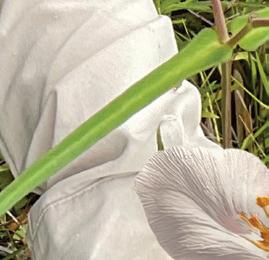
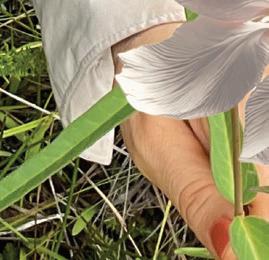















dogwood, crabapple and redbud.


“These are all small native trees with lovely umbrella-type forms that also bloom prolifically in spring,” she says.


Blooming trees and shrubs are pretty, but, more importantly, they provide food for pollinators and other wildlife—such as bees, insects and birds. They are also important larval hosts for butterfly and moth caterpillars that depend on the specific leaf chemistry of native plants
they evolved with. The trees adapted to host caterpillars eating their leaves without incurring harm.
“We want to see holes in the leaves of our native plants because that means they are a functioning part of the food chain,” Lilly says. “Caterpillars are critical sources of protein and nutrients for all wildlife, but especially baby birds.”
Songbird chicks can only eat insects. Without native trees that host caterpillars and other insects, songbird parents don’t have access to the critical food source.







“Songbird populations are crashing, largely due to the loss of habitat that provides them food,” she says. “Ecosystems are delicately balanced machines that provide many services we depend on for our health and happiness, like clean air, clean water, pollination of food crops and extreme weather buffers. “The choices we make in our yards have reverberating consequences on the health of our wildlife and ourselves.”

shades out native trees and plants on the forest floor,” she says. “Its roots prying into the bark can hold moisture and cause splitting or rotting, eventually killing the tree.”
Eliminating English ivy is challenging and can be a multiyear project. The root system must be removed which often requires using a sod cutter. Vines growing vertically up tree trunks must be cut and carefully pulled down once dead to avoid damaging the tree.
owner. Let them know you’re interested in converting your landscape to include native plants. Area horticultural organizations often hold native plant sales, including your local chapter of the Florida Native Plant Society or area Master Gardener groups.”
Floridians can help protect the state’s unique environment by learning about native plants.
“If you have English ivy adjacent to your property but it hasn’t spread there yet, keep a regular eye on it,” Lilly says. “Stopping the spread is much easier than trying to remove large areas.”


“It’s so important that residents are conscious of the implications of invasive species,” Lilly says. “Becoming educated about the benefits of native plants in your landscape can be an excellent first step in helping protect wildlife and the ecosystems that we as humans depend upon.”





Several vining plants are good replacements for English ivy, including Virginia creeper, crossvine, yellow jessamine and native coral honeysuckle.






“Finding good native options for landscaping can be challenging,” she says. “Get to know your local nursery
For more information about native plants and invasive species, how to manage them and where to find native plants, check out the Florida Native Plant Society at fnps.org and the University of Florida Institute of Food and Agricultural Sciences Extension, edis.ifas.ufl.edu.






















Nandina or heavenly bamboo, introduced from Asia as an ornamental shrub, spreads prolifically through its bright-red berries and is now on invasive plant lists.


“It can quickly crowd out native plants,” Lilly says. “The pretty red berries contain natural cyanide, making them toxic to birds, especially cedar waxwing and mockingbirds.”
English ivy, most common in North Florida and the Panhandle, can cause serious ecological and environmental issues. Deemed invasive in many states, it can quickly grow up tree trunks and spread to limbs and nearby trees.
“Like many invasive vines, the sheer weight of English ivy can do severe damage to the trees it covers, plus it
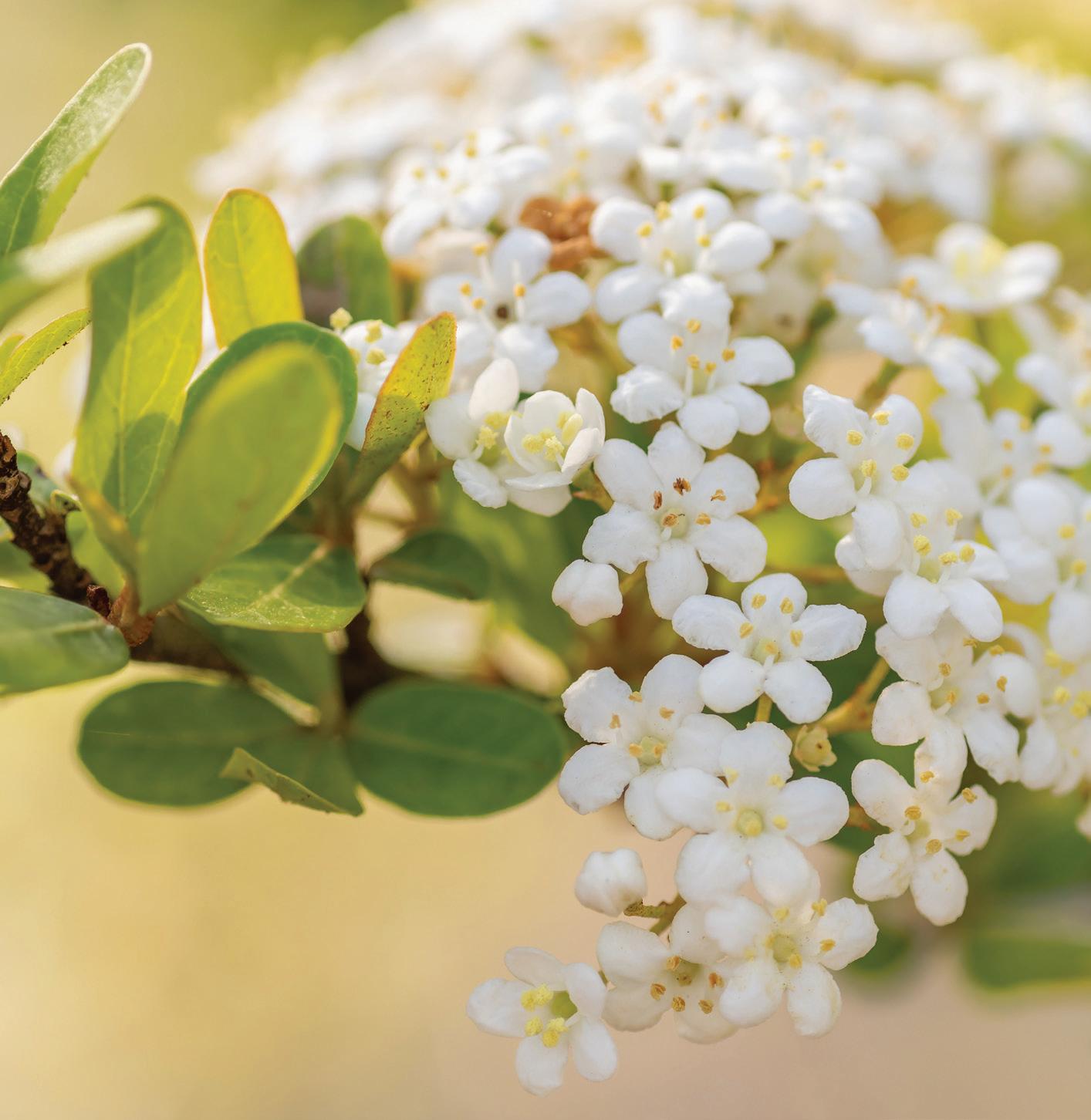




Classic Caprese Pasta Salad
Pasta salad
1 pound of your favorite shaped pasta, cooked and cooled
3 cups grape tomatoes, halved
12 ounces fresh mozzarella cheese balls, plain or marinated, halved
Dressing



½ cup extra-virgin olive oil
4 tablespoons red wine vinegar

1⁄3 cup basil, chiffonade
¼ cup parsley, chopped
1⁄8 cup freshly grated ParmigianoReggiano cheese
Balsamic glaze, for drizzling
1 garlic clove, minced Salt Pepper

In a bowl, combine pasta, tomatoes, cheeses and herbs. In a glass measuring cup, whisk dressing ingredients. Season to taste. Pour dressing over pasta salad, and toss to combine. It’s best if it’s chilled for an hour. Garnish with more basil. Drizzle with balsamic glaze just before serving.


½ cup mayonnaise
½ cup scallions, chopped
½ cup chopped fresh basil, packed
1⁄8 cup freshly squeezed lemon juice
1 clove garlic, chopped
1 teaspoon kosher salt
½ teaspoon freshly ground black pepper
1 teaspoon anchovy paste
½ cup sour cream
Place all ingredients except for sour cream in a blender or food processor. Blend until smooth. Add sour cream and process until blended.
Keep refrigerated until serving on your favorite salad.
½ cup toasted pine nuts
2 tablespoons fresh lemon juice
1 garlic clove
¼ teaspoon sea salt
Freshly ground black pepper
2 cups basil, leaves only
¼ cup extra-virgin olive oil, plus more for a smoother pesto
¼ cup freshly grated
Parmesan cheese
In a food processor, combine the pine nuts, lemon juice, garlic, salt and pepper. Pulse until well chopped. Add the basil. Pulse until combined.
With the food processor running, drizzle in the olive oil. Pulse until combined. Add the Parmesan cheese, and pulse to briefly combine. Add more olive oil if desired.
Vinaigrette
1 shallot, roughly chopped
2 cups tightly packed fresh basil leaves, stems removed (about 4 ounces)
1 clove garlic
Pasta
1 pound pasta
2 tablespoons olive oil
2 cloves garlic
2 shallots, thinly sliced
½ teaspoon red pepper flakes
½ teaspoons red pepper flakes
½ cup olive oil
2 tablespoons red wine vinegar
1 teaspoon salt
1 zucchini, cut into coins
Kosher salt
Freshly cracked black pepper
1 lemon, juiced
Fresh basil
Parmesan cheese
To make the vinaigrette, combine all ingredients in a highpowered blender. Blend for 60 seconds until smooth. Taste and adjust salt and pepper as needed.
Cook the pasta according to the package directions until al dente. Drain and set aside.
In a large skillet, heat the olive oil over medium heat. Add the garlic, shallot and red pepper flakes. Saute until fragrant. Add the zucchini, and saute until just soft. Add the pasta and ½ cup of basil vinaigrette. Toss to combine. Add more basil vinaigrette as needed. Season with salt, pepper and lemon juice before serving.
2 extra-large egg yolks, at room temperature
3 tablespoons freshly squeezed lemon juice
½ cup freshly grated
Parmesan cheese
1 tablespoon Dijon mustard
½ cup chopped fresh basil leaves, lightly packed
1 teaspoon minced garlic
1 tablespoon kosher salt
1 teaspoon freshly ground black pepper
1 cup vegetable oil, at room temperature
½ cup quality olive oil, at room temperature
Place the egg yolks, lemon juice, Parmesan, mustard, basil, garlic, salt and pepper in a food processor fitted with the steel blade. Process for 30 seconds until smooth.
Combine the vegetable oil and olive oil in a liquid measuring cup. With the processor running, slowly pour the oil mixture through the feed tube to make a thick emulsion.
Store in the refrigerator until ready to use; it will keep for up to a week. Serve with beef tenderloin or steak.
Baguette bread, preferably stale, cut into 1-inch cubes (about 3 cups)
6 tablespoons extra-virgin olive oil, divided
1 teaspoon kosher sea salt, divided
2 pounds ripe tomatoes, any variety or color
8 ounces fresh mozzarella, torn into bite-size pieces
½ cup thinly sliced red onion
2 garlic cloves, grated to a paste
2 tablespoons red wine vinegar, divided
1 teaspoon dried oregano
Large pinch red pepper flakes
½ teaspoon Dijon mustard
Black pepper
1 cup sliced English cucumber
½ cup torn basil leaves
¼ cup flat-leaf parsley leaves, roughly chopped
Heat oven to 425 F. Spread the bread cubes on a baking sheet, and toss with 2 tablespoons oil and a pinch of salt. Bake until dried out and golden brown at the edges, about 10 minutes. Let cool.
Cut tomatoes into bite-size pieces, and transfer to a large bowl. Add mozzarella, onions, garlic paste, 1 tablespoon vinegar, oregano, ¼ teaspoon salt and red pepper flakes. Toss to coat, then set aside.
In a medium bowl, combine remaining 1 tablespoon vinegar, mustard, ¼ teaspoon salt and black pepper to taste. While whisking constantly, slowly drizzle in the remaining 4 tablespoons of olive oil until the mixture is thickened. Stir in cucumbers, basil and parsley.
Add bread cubes and cucumbers to the tomatoes. Toss well. Let sit for at least 30 minutes and up to 4 hours before serving. Toss with a little more olive oil, vinegar and salt if needed just before serving.
By Dave LaBelle
I have written in past years about the merits of photographing people from the back, but the concept is worth repeating.
Body language—or gesture, as it is often called—can convey much in a still photograph. We can often tell a lot about a person’s disposition just by the way they carry themselves.
Whether overt gestures such as raising a fist in protest or outstretched hands imploring agreement speak loudly, the quieter, subtle gestures—such as the way one walks, or tilts their head when speaking or listening—can also communicate a lot when our eyes pay attention.
If you have never closely studied Rembrandt’s “The Return of the Prodigal Son,” I suggest you give this masterpiece a serious look. Beyond the mood-setting color, the postures of the son, father and brother—especially the positions of the hands—are powerful details employed to tell this compassionate story in one of the artist’s greatest works.
A few years ago, I was walking in the hills with a dear friend, Mark, after he had lost his oldest son. He often took long hikes alone to pray. He asked one day if I would walk with him. I did not carry a camera on this day, but I did have my cellphone.
Following behind on the narrow path,

the movements of his body—sometimes unsteady on the stony path—felt like a metaphor for his life then.
I know you are struggling day by day, I observed.
He softly answered, “It is more like hour to hour.” n
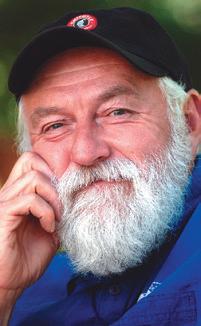
than
sharing
tips and life perspectives
Capture a storytelling photograph without showing a person’s face. Pay attention to body language. Watch how one sits or walks and where they do so. It’s not uncommon to see older men ambling alone with their hands folded behind them.
readers. For more of his writings, visit davidlabelle.com and his blog at bridgesandangels. wordpress.com. iPhone 6s, 4.2mm lens
Email your best image—just one—with caption information, including an explanation of how it affects you, to gph@pioneer.coop. We may share submissions on our website and social media channels.
ISO 25, f/2.2 at 1/2959

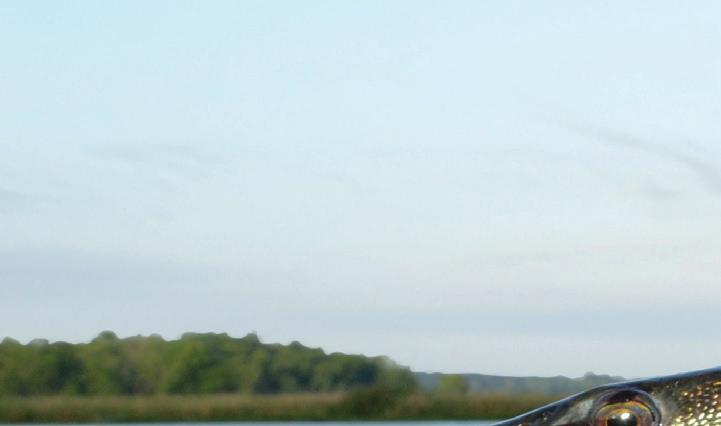






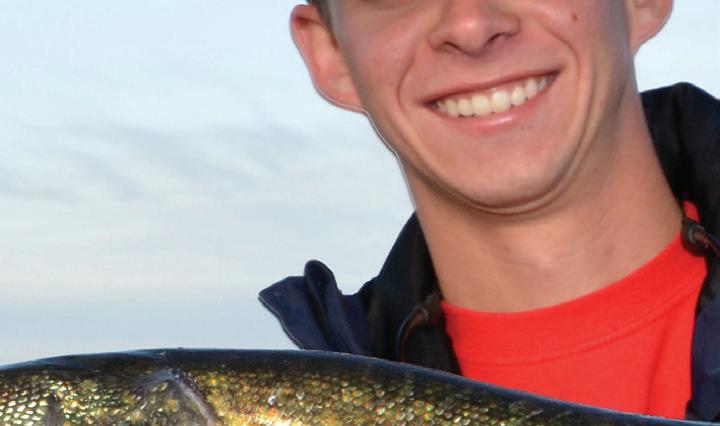




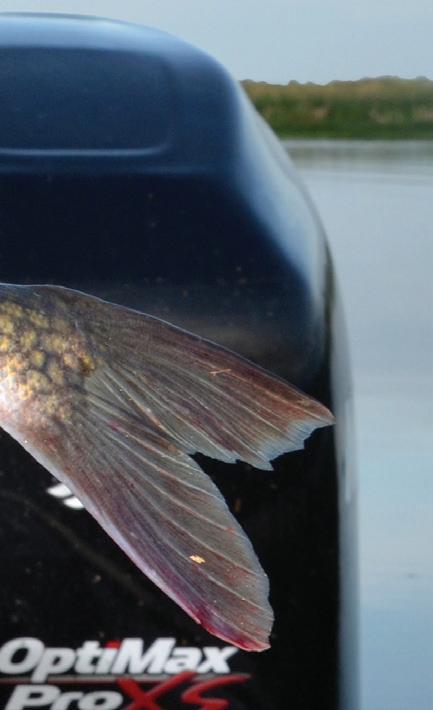
A toothy Florida native offers outstanding sport all over the Sunshine State, yet few people fish for it.
“Chain pickerel are found in most waters throughout Florida,” says John Cimbaro, a Florida Fish and Wildlife Conservation Commission biologist. “Not very many people target pickerel in Florida. Most people catch them incidentally while fishing for other species, like bass. Anyone who hooks into a pickerel can expect some exciting runs and jumps.”
Closely related to northern pike and muskellunge, chain pickerel resemble green torpedoes. Built for speed, this fish can exceed 30 inches and weigh more than 9 pounds. A fish caught in Lake Talquin holds the Florida state record at 6.96 pounds.
Frequently called jackfish, duckbill or snakefish, pickerel hit extremely hard, fighting with speed and tenacity. They thrive in weedy waters, where their splendid splotchy green camouflage hides them. When an enticing morsel passes close, these toothy terrors launch from their lairs, seizing prey with razor-sharp teeth.
“Chain pickerel are almost always found near vegetation,” John says. “In streams
or rivers, they like quieter pools. Like a barracuda, their streamlined bodies are designed for the same kind of high-speed ambushes and chases. They are big fish eaters, but they eat a varied diet to include frogs, crawfish, snakes and even small mammals, like mice.”
Pickerel commonly attack lures meant for largemouth bass, particularly anything that mimics shad, bream or shiner. Such “fishy” lures often provoke brutal strikes from terrifying predators. Some better lures include spinnerbaits, jerkbaits, weedless spoons and crankbaits.
Pickerel occasionally hit topwater baits. They especially like frogs buzzed across matted grass. Live shad, wild river shiners and other fish make great natural baits.
“Chain pickerel are very fun to catch and will hit almost anything that a largemouth bass will hit, but they like flashy lures more than soft plastics,” says Mark Shepard, a bass guide. “Lake Okeechobee has quite a few chain pickerel. We catch them with rattling baits, crankbaits and spinnerbaits. We also catch pickerel on weedless spoons worked over matted grass tops.”
Chain pickerel range throughout
Florida. Anglers might catch a pickerel on any cast in any weedy freshwater system. Some better waters include lakes such as Seminole, Talquin, Jackson, Panasoffkee, the Kissimmee and Harris chains, and the St. Johns River system.
“Anglers might catch pickerel almost anywhere in the state,” John says. “(Those) wanting to target chain pickerel should concentrate on lakes and rivers in northcentral or northwest Florida. In southeast Florida, the Everglades Water Conservation Area canals hold pickerel. Fly anglers should throw quickly retrieved, bright or flashy streamers.”
Although bony, big pickerel are excellent for eating. However, anglers should handle pickerel with care. When grabbed, the incredibly agile fish can easily bend their bodies and sink their teeth into flesh or drive a hook into a finger. Sharp gill plates can slice flesh. Use pliers to unhook them. John N. Felsher is a freelance writer, broadcaster, photographer and editor. He’s written more than 3,500 articles on a wide variety of outdoor topics. Contact him at j.felsher@hotmail.com or through Facebook.










By Drew Woolley










ages, cooperatives have learned a few helpful tricks to resonate with younger audiences. Hands-on activities, such as asking kids to look through their backpacks for electronic devices and calculating how much energy they use, can drive home just how much electricity they use in their daily lives. Meanwhile, avoiding technical terms like “energy efficiency” can help saving energy feel less daunting and more fun.

Everyone likes finding ways to save on their energy bill. But watching the thermostat like a hawk, turning off lights behind everyone in the house and sweating an investment in energy-efficient appliances isn’t much fun, especially when you’re trying to get the kids to play along. Fortunately, electric cooperatives have been working to make energy savings more approachable for many years. After decades of educating kids of all







AIGENERATED ILLUSTRATION
BY FREEPIK/BRANDON POMRENKE


Even so, some of the most effective ways to drive home the importance of energy conservation are the routine reminders members may have heard from their parents growing up. Luckily, there are still plenty of ways to teach your kids the importance of energy conservation while having fun as a family.





Here are some fun ways to encourage energy efficiency and conservation at home: Cook a family-powered dinner. Have the whole family help cook dinner with one rule: No electricity is allowed. Avoid using major kitchen appliances like electric ovens, blenders, mixers or
microwaves to teach kids about common ways your family uses electricity during peak demand times. Top it all off with some no-bake treats.




Take turns on power patrol. Every child enjoys being in charge from time to time. Take turns letting everyone in your family be responsible for enforcing good energy habits around the house for a week. You can even set up a point system for every time they notice a light left on in an empty room, unplug unused electronics chargers or adjust the thermostat to a more efficient setting. Offer prizes and rewards to encourage them to be mindful of energy use every day.








Build an energy-efficient dream home. Encourage everyone to design their dream home with energy-saving features in mind. This is a great way to introduce ideas like solar panels, efficient appliances and sustainable building materials. Break out the crayons and art supplies to bring their homes to life, or use household crafts to build models.











Play energy-saving bingo. Make bingo cards with squares for energysaving actions like using natural light instead of lamps or ceiling lights, unplugging devices, turning off lights and cooling off the temperature by opening a window. Kids can cross out each square as they complete each task, and the first one to bingo gets a prize.








Have power-free fun. Designate one night a week as power-free time when everyone in the family turns off phones, computers and TVs together. Play a board game, spend time reading your favorite books or enjoy some outdoor activities technology-free. Save on your electric bill, teach the importance of reducing energy use during peak periods and get some valuable family time all at once.




Make an energy-saving scavenger hunt. Make up a list of energy-saving practices, such as updating light fixtures with LED bulbs, turning off lights in empty rooms and unplugging










unused devices. Challenge your kids to search the house and check off an example of each scavenger hunt item. You can celebrate with small prizes or treats for each energy-efficient discovery they make along the way.




Create energy-efficient art. Kids enjoy seeing their artwork displayed, so put those creative skills to work on energy-efficient reminders around the house. Spend arts and crafts time teaching your kids about some of the steps they can take to save energy around the house. Make fun signs to serve as daily reminders to close the fridge quickly, turn off lights and only change the thermostat as a last resort.







every time someone spots an unused device still plugged in. Set a goal and reward yourselves when everyone keeps phantom energy use down.
No matter what you do to keep energy savings fun around the house, the most important part of instilling good habits is reliably reminding your family of the little steps they can take to be more efficient. Consistency is key.


Keep “phantom power” waste bottled up. Phantom energy—the electricity devices use even when they are turned off— can be a tricky concept for kids to understand. Illustrate it in a fun way by adding marbles to a glass bottle or jar




















All ages can find something new and exciting around every corner of the state. Filled with rich history, abundant natural beauty and diverse events all year, Florida has something fun for everyone.
Aug. 2
William Shatner Live On Stage with ‘Star Trek II: The Wrath of Khan’
Set your phasers to stun! Prepare to be beamed up for an unforgettable night with the original Capt. James T. Kirk, award-winning actor William Shatner. Following a screening of the classic film “Star Trek II: The Wrath of Khan,” Shatner takes to the stage to share fascinating and humorous behind-the-scenes stories from his career and answers audience questions. VIP tickets include a postshow photo op with Shatner. You don’t want to miss this warp-speed, once-in-a-lifetime adventure. bit.ly/4nqEV0x; 850-595-3880
Aug. 2
History Tour of Camp Helen State Park

Join a park ranger from 10-11 a.m. CST for a guided tour of the grounds. Follow along as staff share park history from the Hicks family building the historic structures that still stand on the grounds, all the way through the colorful history of Avondale Mill using the property as its employee vacation retreat. Dress appropriately for the weather. Park entry fee is $4 per vehicle or $2 per pedestrian or bicycle in the honor box at the entrance or via the QR code on the entry sign.
floridastateparks.org/events/history-tour-36; 850-245-2157
Aug. 3
Guided Bird Walk
Come meet the birds at Anastasia State Park and join a knowledgeable park volunteer for an informative walk on the beach, boardwalks, trails and other areas. Participants of all birding levels may observe a diverse variety of seabirds, shorebirds and wading birds. Dress for the weather and bring binoculars, comfortable walking shoes and a field guide if you have one. Meet at the Island Beach Shop & Grill at the end of the main park drive. This walk is free with regular park admission fee: $8 per vehicle with two to eight people; $4 per single-occupant vehicle; and $2 per pedestrian, bicyclist, extra passenger and passenger in vehicle with holder of Annual Individual Entrance Pass.
floridastateparks.org/events/guidedbird-walk-119; 850-245-2157

Aug. 2 & 16
Salt Air Farmers Market
Join us from 9 a.m. to 1 p.m. on the first and third Saturdays in discovering fresh produce, handmade crafts, plants, and more from local farmers and artisans. This dog-friendly market offers a fun, family-friendly experience in a shaded downtown park at the corner of U.S. 71 and Reid Avenue.
saltairmarket.com; 850-373-7379
Aug. 6
Library Summer Reading Program: Reno’s Reptiles
Join us from 10:30-11:30 a.m. at Big Lagoon State Park for a reptile showand-tell as alligators, tortoises and other critters visit your local library. All ages are welcome. Visitors receive free entry to the park for this event with their library card. If visitors wish to remain in the park after the event, they should obtain a $6 day pass per vehicle.
floridastateparks.org/events/library-summer-reading-program-renos-reptiles.com; 850-245-2157


Aug. 8
Cinema in the Sand
Presented by the Santa Rosa Island Authority, this beloved tradition invites locals and visitors to gather under the stars, feel the sand between their toes and enjoy timeless movie classics against the breathtaking backdrop of the Gulf of Mexico. This month’s movie is “Shrek.” www.visitpensacolabeach.com; 850-530-3349
Aug. 9
Smokey Bear’s Birthday Celebration
Come celebrate Smokey Bear’s 81st birthday from 9 a.m. to 1 p.m. at Mike Roess Gold Head Branch State Park. The party includes several activities to educate and promote prescribed fire, including a prescribed burn demonstration, touch-a-fire-truck, Smokey Bear storytime and a meet-andgreet. This event is free with park entry of $5 per vehicle. floridastateparks.org/events/smokey-bears-birthday-celebration-0; 850-245-2157

Aug. 15
Gallery Night: Retro Rides and Art Vibes ‘Car Show’
Presented by Publix, this event brings the streets of downtown Pensacola to life with more than 70 art vendors showcasing their work along Palafox Street. Stroll through a vibrant, open-air market filled with local artists, live performances and creative experiences, all celebrating Pensacola’s thriving arts scene. www.gallerynightpensacola.org
Aug. 16
Bathysphere Anniversary Tours
Join the History of Diving Museum at 11 a.m. and 2 p.m. for special guided tours of the exhibits. The tour is included in the admission price. August’s tours coincide with the 91st anniversary of William Beebe and Otis Barton’s historic dive in the Bathysphere, which took the two men to 3,028 feet in 1934. These tours feature highlights of the Bathysphere and its incredible feats. divingmuseum.org; 305-664-9737
Aug. 23
Early American Pie-Making Class
Join expert volunteers and staff as they teach participants the historic art of early American pie-making with wild berries. Preregister at the number below. Participation cost is $10 per person in addition to $3 per vehicle or a Florida State Parks Annual Pass. floridastateparks.org/events/early-american-pie-making-class; 352-793-4781



Aug. 7
Truman Waterfront Farmers Market

Shop with a view from 2-7 p.m. on the harbor by the USCG Ingham Museum at the corner of Southard Street and Weech Way. Find great food options—including ready-to-eat items, fresh Florida produce and other grocery items—along with gifts, home decor and art. keysartisanmarket.com; 305-731-3385

Aug. 30
Gulf County Labor Day Rodeo
Dust off your boots and get ready for a night of heart-pounding rodeo action, with gates opening at 5:30 p.m. and the rodeo starting at 7:30 p.m. at TL James Park. This family-friendly event promises a spectacular showcase of traditional rodeo events. The evening features crowd favorites such as bull riding, barrel racing and roping. Whether you’re a longtime rodeo fan or just looking for something exciting to do over Labor Day weekend, this event delivers big thrills and smalltown fun. Tickets are $20 for those 13 and older and $10 for 6- to 12-year-olds. Children 5 and younger enter for free.
bit.ly/44yNQo5; 850-229-7800
Aug. 30-31
Florida Scallop, Music and Arts Festival
Featuring the best arts and crafts vendors from the region and incredible food vendors, this annual event at George Core Park offers a full music lineup across both days. Tickets are sold at the gate as one- or two-day passes—$10 and $20, respectively. Children younger than 12 given free admission. Bring a lawn chair, but outside food and drinks are not allowed. www.gulfchamber.org/annual-monthly-events; 850-227-1223
Want to share a family-friendly event with the readers of Florida Currents? Head online and enter the details at tinyurl.com/FloridaCurrents or use the QR code for easy access. Make sure to submit the item at least 60 days before the event (due to press deadline). If you own rights to a print-quality photo promoting your event, include it with photo credit information.










Trundling along,
Dipped brow.
Weighty preponderance.
What contemplation droops the brow
Of one so bright?
Flirting with ephemerality,
A bouncing farewell.
Corolla left trembled
From the footsteps
Tickled surfaces.
The gift of pollen delivered.
— Alyssa Vinson
We follow the spiral of humming locomotion as a bee dips and trundles, sipping nectar and inadvertently ushering in the reproduction of flowers. Pockets overfull with golden pollen or dusted daftly across the fuzzy hairs of their abdomens— sometimes so rotund that flight seems impossibly comical.
Bees arrive in the periphery of our awareness, often only the focus when we fear the sting. These harbingers of pollination and many other beneficial services are often overlooked when conversations emerge around the topic of saving pollinators. Butterflies are so much more gregarious and therefore receive an outsized portion of our gardening attention. Bees of all sorts, and particularly native bees, are essential components of a vibrant and healthy local environment.
The common honeybee (Apis mellifera) is not native to North America. Originating in areas of Africa, this bee traversed the globe with human settlement. Used for centuries by humans for their honey, comb, wax and pollination services, honeybees are iconic and familiar. Less well known are the hundreds of species of native bees that evolved in our specific ecosystems.
The broad diversity of native bees includes bees of vibrant and gleaming green or blue, fuzzy bumblebees fatter than your thumb, and bees so small they might be mistaken for flies.
In Southwest Florida you may come across bright green sweat bees, metallic dark blue mason bees or the fuzzy large bumblebee.
While honeybees have the advantage of commercialization and industry to support their continued health and growth, native bees rely on the abundance and diversity of plant species in our landscapes and natural areas for their survival. Significant declines in insect populations and diversity are documented across the globe. Bees native to Florida developed

specific relationships with native plants over the course of their evolution. They provide significant ecosystem services in terms of pollination and act as key components of many food webs.
To encourage native bees in your landscape, plant a diversity of flowering plants, including different colors, shapes, sizes, forms and structures. Bees love plants with short- or mediumlength flower tubes to easily access the pollen and nectar, and they tend to prefer flowers that are white, yellow, blue or purple.
Remember to provide bees with plants that have not been treated with systemic insecticides, and limit the use of pesticides in your landscape.
For more information on how to encourage native bees to visit your landscape, visit edis.ifas.ufl.edu/publication/IN1255.
To understand the types of bees in Florida, read this guide from UF/IFAS: edis.ifas.ufl.edu/publication/IN1285.

Alyssa Vinson is the Urban Forestry Extension agent in Hillsborough County. Alyssa has lived in and explored Florida for almost 20 years. She serves residents and professionals of southwest Florida with programs on all things “tree.”
Electricity is essential for everyday life, but when combined with seemingly harmless items or elements, it can create a hazardous situation. View the grouped items below, then circle the two items that (when combined) create a potential electrical hazard.
Check your work in the answer key below.
1.
2.







Delete deceptive emails. If you receive an email that appears to be from your electric cooperative but you are unsure about it, delete it.
Never click on a link, open an attachment or send a reply to an untrusted source. When in doubt, contact your co-op directly to report suspected email scams.
Source: Utilities United Against Scams
As August rolls in with long days and rising temperatures, it also brings the increased potential for severe weather. Summer storms can arrive quickly and hit hard, sometimes causing significant damage to essential electric equipment throughout our community.
Glades Electric Cooperative is always prepared to respond swiftly to outages and restore power safely, but it’s also important for homeowners to understand which parts of the electric system are their responsibility and which are maintained by the co-op. Understanding these key differences can help speed up repairs and ensure everyone stays safe when the weather turns rough. The co-op is responsible for maintaining and repairing the equipment and lines that run to your home,
including utility poles, distribution power lines, electric meters and padmounted transformers.
Glades Electric members are responsible for the weatherhead, service mast and meter socket located outside the home.
If any equipment the homeowner is responsible for is damaged, they should call a licensed electrician to conduct the repairs. A professional has the experience and know-how to assess and manage these repairs.
When severe weather damages electrical equipment, it’s important to note any necessary repairs to the member’s equipment must be conducted before Glades Electric crews can restore power to the home or business. By understanding the equipment members are responsible for, the repair and restoration process can be smoother and faster.
Our community takes great pride in the beautiful trees and landscaping that contribute to the area’s natural beauty. However, regular trimming is essential to ensure reliable electric service and minimize damage from severe weather. Glades Electric regularly trims trees throughout its service territory to improve service reliability.
If you spot a tree limb obstructing a distribution power line outside your home, call 855-940-3810 so the co-op can trim those limbs and maintain those lines.
By working together to understand the essential equipment that powers daily life, all parties can be prepared to start any necessary repair and restoration process if severe weather impacts the community.
If you have any questions about your electrical equipment, Glades Electric is here to help. Contact the cooperative through SmartHub or at 855-940-3810. n













This graphic depicts equipment owned by the co-op (in gold) and the member (in blue). If a storm damages any equipment owned by the co-op, we are responsible for repairs. If a storm damages any member-owned equipment, the member is responsible for repairs. Members should hire a licensed electrician when making any repairs to member-owned equipment.
Note: This graphic

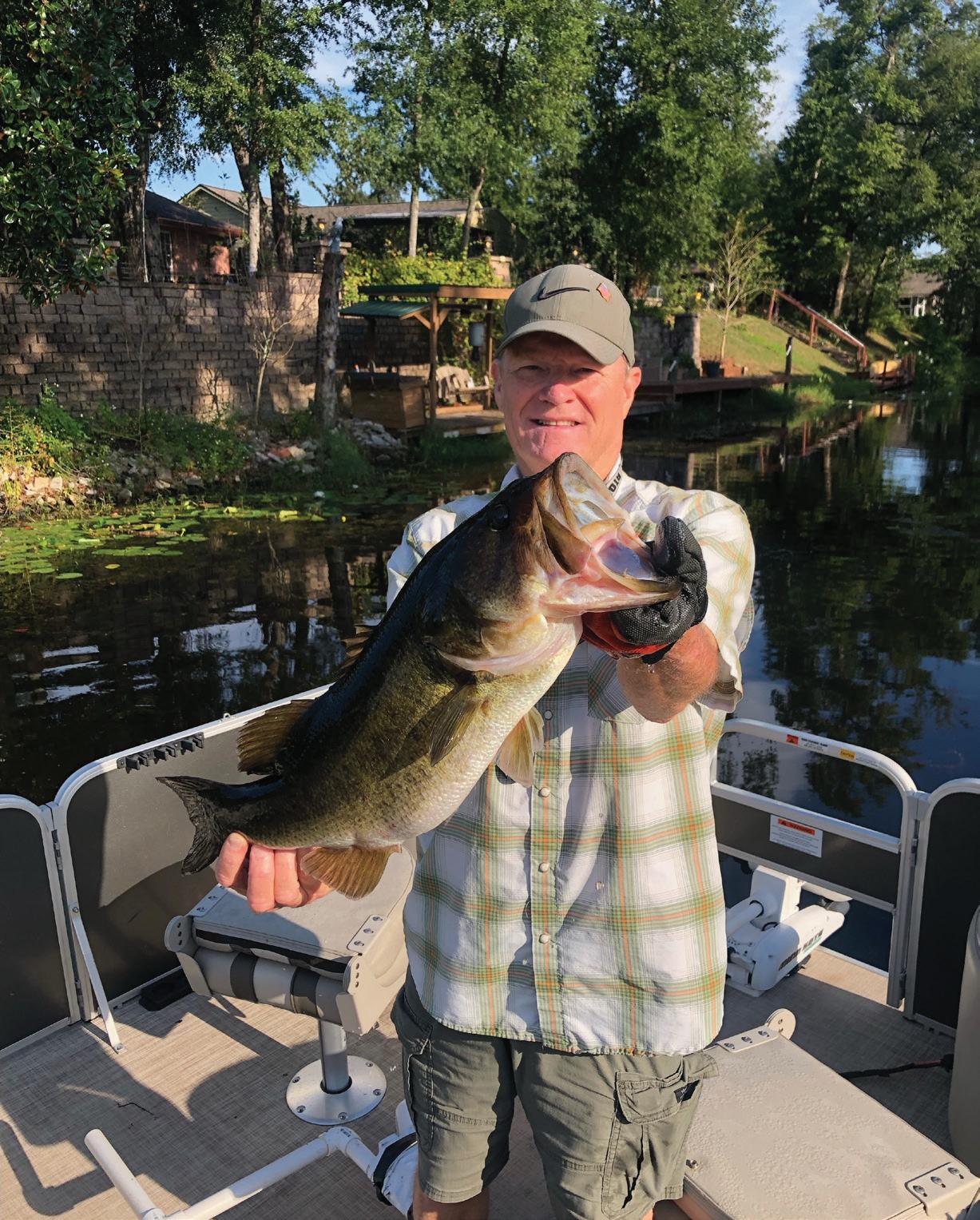
From lakes to the ocean and parks to beaches, Florida’s geography is vast and beautiful. Some of you have views from your homes that rival the views of national parks.
From time to time, we share some readers’ photos in this space. If we use your photo here, we will send you your choice of a $25 gift card to REI or Amazon.
To submit your photo, email a JPEG file to photos@floridacurrents.com. Include “Before You Go” in the subject line. Please share a bit about what inspired you to make your photo.




More than 2 people die from skin cancer every hour. See something new, changing or unusual? It could be skin cancer. Check yourself for The Big See today.
Electric Cooperative, Inc. “Neighbors Working for Neighbors”
CONTACT US
855-940-3810 www.gladeselectric.com
OFFICES
7 a.m. to 6 p.m. Monday through Thursday
26733 U.S. Hwy. 27
P.O. Box 519 Moore Haven, FL 33471
214 SR 70 W. Lake Placid, FL 33852
REPORT AN OUTAGE
Via the SmartHub app ~ 855-940-3810 (24/7 outage reporting)
Please have your account number ready.
BOARD OF TRUSTEES
Lee Henderson, President, District 6 Highlands Park, 863-633-9281
Barney Goodman, Vice President, District 2 Hendry County, 561-414-8737
Shannon Hall, Secretary/Treasurer, District 4 Lakeport and Brighton, 863-946-3242
Donnie Lundy, Trustee, District 1 Moore Haven, 863-634-7314
Mike Pressley, Trustee, District 3 Ortona and Palmdale, 863-673-9158
Brad Oxer, Trustee, District 5 Venus and Hicoria, 863-441-1866
Fred Tagtmeier, Trustee, District 7 Lorida, 863-214-4994
Vicki Pontius, Trustee, District 8 Lake Josephine, 863-414-2917
Angela Hodges, Trustee, District 9 Okeechobee, 863-801-3140
The board’s next meeting is at 9 a.m. Aug. 28, at Moore Haven Headquarters Office. Any changes are posted in the lobby of both district offices.
EXECUTIVE STAFF
Jeff Brewington, CEO
Michael Roberge, Acting General Manager
Renee Bass, Chief Administrative Officer
Courtney Brown, Chief Personnel Officer
Jennifer Koukos, Chief Communications Officer
Jennifer Manning, Chief Financial Officer
Our thoughts and prayers go out to the victims, their families and all the first responders affected by the terrible flash flooding tragedy in Texas. It’s a harsh reminder of how important emergency planning is and why it is critical to have a plan.
It is important to be aware of your surroundings—whether outdoors or inside—including flood zones; emergency exits in a restaurant, church, stadium, concert hall or other large gathering area; and shelters in outdoor spaces, such as a beach or golf course. Knowing where emergency exits or shelters are could save your life.

The Texas flooding catastrophe also highlights the importance of being able to receive emergency information. We all should have a battery-powered radio in our emergency kit. Even better is a weather radio with active alerts 24/7. We all know how bad weather seems to strike at night, so don’t disable those nighttime alerts.
With tropical systems forming and intensifying faster than in the past, it’s important to remain alert and connected.
Fortunately, the technology to predict storm tracks is improving, but we need to be ready to respond when the alerts are posted. Case in point is Hurricane Erick, which made landfall June 19 in Mexico. It was the first major hurricane—Category 3 or greater—on record to hit Mexico before July. The hurricane maxed out as a ferocious Category 4 storm with 145 mph winds. Erick underwent extreme rapid intensification from Tuesday night into Wednesday night, strengthening from a tropical storm to a Category 4 hurricane in just 24 hours. This underscores the importance of heeding alerts and warnings when they are posted.
To receive important co-op alerts, keep your phone numbers and email address updated with Glades Electric Cooperative. Call us at 855-940-3810 to speak to a member service representative or use our SmartHub app anytime to update your information. Emails, phone calls, texts and SmartHub alerts are our primary communications channels during an emergency event.
Our Glades Electric storm team meets to discuss our individual roles and responsibilities and any unique features of an incoming system prior to storms. You can be confident that we are doing everything we can to respond quickly and safely when the time comes.
Together, we can weather the storms.
